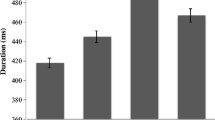Abstract
Heavy-NP shift is the tendency for speakers to place long direct object phrases at the end of a clause rather than next to the verb. Though some analyses have focused on length of the direct object phrase alone, results from two experiments demonstrate that the length of the direct object relative to that of other phrases, and not the length of the direct object alone, predicts production of the shifted structure. These data support an accessibility-based interpretation of length effects in word order emerging from incremental production processes, in which longer phrases tend to be less easily planned and therefore are delayed during utterance planning.
Similar content being viewed by others
References
Arnold J. E., Wasow T., Losongco A., Ginstrom R. (2000) Heaviness versus newness: The effects of structural complexity and discourse status on constituent ordering. Language 76: 28–55
Bock J. K., Levelt W. (1994) Language production: Grammatical encoding. In: Gernsbacher M. A. (eds) Handbook of psycholinguistics. Academic Press, San Diego, CA, pp 945–984
Bock J. K., Warren R. K. (1985) Conceptual accessibility and syntactic structure in sentence formulation. Cognition 21: 47–67
Bresnan J. (2007) Is syntactic knowledge probabilistic? Experiments with the English dative alternation. In: Featherston S., Sternefeld W. (eds) Roots: Linguistics in search of its evidential base. Mouton de Gruyter, Berlin, pp 77–96
Chang F. (2009) Learning to order words: A connectionist model of heavy NP shift and accessibility effects in Japanese and English. Journal of Memory and Language 61: 374–397
De Smedt K. (1994) Parallelism in incremental sentence generation. In: Adriaens G., Hahn U. (eds) Parallel natural language processing. Ablex, Norwood, NJ, pp 421–447
Dryer M (1980) The positional tendencies of sentential noun phrases in Universal Grammar. The Canadian Journal of Linguistics 25: 123–195
Emonds J. (1976) A transformational approach to English syntax. Academic Press, New York
Givón T. (1988) The pragmatics of word order: Predictability, importance, and attention. In: Hammond M., Moravcsik E. A., Wirth J. (eds) Studies in syntactic typology. John Benjamins, Amsterdam, pp 243–284
Hawkins J. A. (1994) A performance theory of order and constituency. Cambridge University Press, Cambridge, England
Kimball J. (1973) Seven principles of surface structure parsing in natural language. Cognition 2: 15–47
Lombardi L., Potter M. C. (1998) Syntactic priming in immediate recall of sentences. Journal of Memory and Language 38: 265–282
McDonald J., Bock K., Kelly M. H. (1993) Word and world order: Semantic, phonological, and metrical determinants of serial position. Cognitive Psychology 25: 188–230
Quirk R., Greenbaum S., Leech G., Svartvik J. (1972) A grammar of contemporary English. Longman, London
Race, D. S. & MacDonald, M. C. (2003). The use of “that” in the production and comprehension of object relative clauses. In Proceedings of the 25th annual meeting of the cognitive science society.
Ross, J. R. (1967). Constraints on variables in syntax. Unpublished PhD Dissertation, MIT.
Stallings L., MacDonald M. C., O’Seaghdha P. G. (1998) Phrasal ordering constraints in sentence production: Phrase length and verb disposition in heavy-NP shift. Journal of Memory and Language 39: 392–417
Staub A., Clifton C., Frazier L. (2006) Heavy NP shift is the parser’s last resort: Evidence from eye movements. Journal of Memory and Language 54: 389–406
Wasow T. (1997) End-weight from the speaker’s perspective. Journal of Psycholinguistic Research 26: 347–361
Wasow T., Arnold J. (2003) Post-verbal constituent ordering in English. In: Rohdenburg G., Mondorf B. (eds) Determinants of grammatical variation in English. Mouton, The Hague, pp 119–154
Yamashita H., Chang F. (2001) “Long before short” preference in the production of a head-final language. Cognition 81: B45–B55
Zec D., Inkelas S. (1990) Prosodically constrained syntax. In: Inkelas S., Zec D. (eds) The phonology-syntax connection. CSLI and the University of Chicago Press, Chicago, pp 365–378
Author information
Authors and Affiliations
Corresponding author
Rights and permissions
About this article
Cite this article
Stallings, L.M., MacDonald, M.C. It’s not Just the “Heavy NP”: Relative Phrase Length Modulates the Production of Heavy-NP Shift. J Psycholinguist Res 40, 177–187 (2011). https://doi.org/10.1007/s10936-010-9163-x
Published:
Issue Date:
DOI: https://doi.org/10.1007/s10936-010-9163-x




